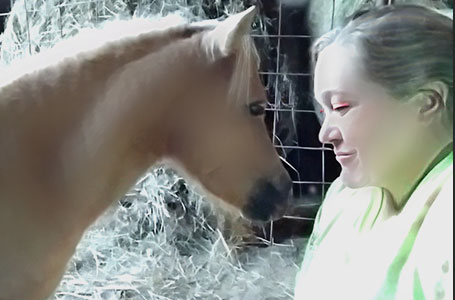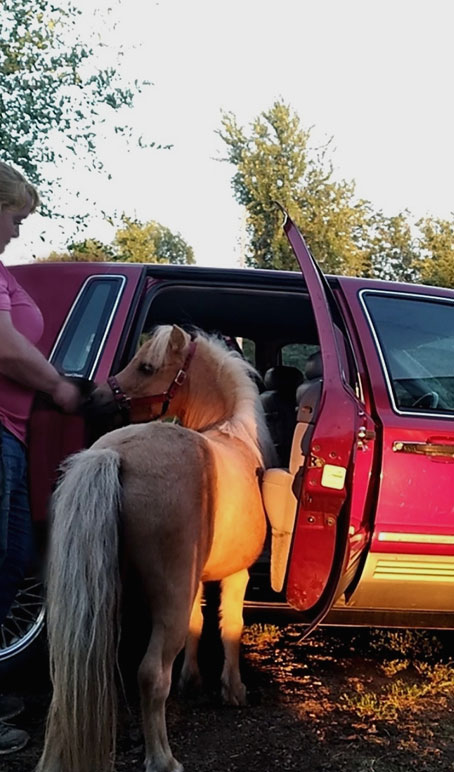Email Address
equineeyes1@gmail.com
Call Us For Support
217-520-5083
Horse Training Program
Where Purpose Meets Precision
At Equine Eyes, our training program is the cornerstone of our mission. Training a miniature guide horse is a long-term commitment that requires 12 to 24 months, depending on the horse’s age, maturity, and learning style. Each horse progresses at its own pace, and under no circumstances is a horse rushed or forced. Each miniature horse accepted into our program undergoes a comprehensive, compassionate, and highly specialized training process.
Our Approach
We follow a positive reinforcement-based training model (+R), also referred to as clicker training. +R training means using an audible click & treat reward (e.g., healthy treats and praise) to encourage desired behaviors. Since the reward increases the likelihood that your horse will repeat the behavior, it helps you in shaping your horse’s responses.
Training starts with essential groundwork skills, manners, and desensitization. It then progresses to more complex tasks, including navigating public spaces, stopping at curbs, avoiding obstacles, and responding to voice commands.
Each horse is taught to remain calm in high-traffic environments, adapt to indoor settings, and handle the unpredictability of everyday life with confidence and composure.

Phases of Training (condensed from extensive list)
- Introduction to Clicker Training: We focus on polite treat receiving, “charging the clicker,” and target touch. Potty training begins (click & treat every time you see the horse potty).
- Foundation Basic Training: This involves grooming, self-stop, and standing quietly with you or while tied. Learn to lift each leg to facilitate hoof trimming.
- Environmental Exposure: Gradual introduction to various surfaces, noises, objects, small groups of people, up & down stairs, loading in and out of a vehicle.
- Public Access Training: Real-world scenarios in publicly accessible places such as malls, parks, restaurants, grocery stores, crosswalks, and more. A service horse should be fully potty trained by this point.
However, since the service horse is still in training, he will wear a discreet “doo-drop” bag in public settings to avoid a potty accident. When a horse is startled, a natural reaction is to poo.
The “doo-drop” bag ensures that an accident stays concealed, leaving no mess. The “doo-drop” bag is an original creation, designed and hand-made by Holly Fisher. Contact Equine Eyes if you’d like to purchase a “doo-drop” bag for your service horse. All proceeds will be donated directly to Equine Eyes to support our mission.
- Mobility Tasks: Guiding in a straight line, identifying and alerting to changes in elevation, locating doorways to enter buildings, and avoiding obstacles; navigating around potential hazards such as overhead and ground-level obstacles, following directional cues, and exercising intelligent disobedience.
- Handler Match Training: Once selected, the new handler will be paired with one of our service horses. The team will collaborate under the guidance of the horse trainer, educational professionals, and our volunteer staff to foster communication, trust, and teamwork.
Lifelong Support

Even after placement, we remain engaged. Equine Eyes provides ongoing support, ensuring that each horse-handler team continues to thrive together. Our commitment is lifelong—because true independence should never be temporary.
Each horse that we place is the property of Equine Eyes and will remain our property for its lifetime. Each recipient will be said to “lease” the horse, and if there is ever a time when the recipient can’t care for the mini horse, we will take possession of the horse to be cared for by Equine Eyes or placed in another home.
Each person who receives an Equine Eyes mini horse is required (via the terms of our agreement) to inform us within 48 hours if they are no longer able to care for the mini horse or cannot provide a basic standard of care. During this timeframe, we will retrieve the mini.
Recipients are not permitted to breed the service horse. The recipient will agree to utilize the service horse regularly to mitigate their disability. They cannot “lose interest and not provide for their needs”. Equine Eyes also retains the right to our service horse from the recipient’s property if a threat is realized that endangers the safety and well-being of our service horse.
If the person becomes ill, takes an extended vacation, goes to prison, or is otherwise unable to care for the horse, the recipient or their immediate family members will inform Equine Eyes within 48 hours of the illness. At the option of our Board members, we will either “babysit” the service horse, free of charge, for the duration required. Or the mini horse will be rehomed to a recipient we deem acceptable.
Selecting a Horse for our Training Program
Not all miniature horses are suitable for guide work. We carefully select horses based on:
- A calm, intelligent, and people-oriented temperament
- Small size, typically 27”–33” inches tall
- Free of hoof & bone abnormalities
- No apparent signs of dwarfism
- Aged 15 years or younger
Our mini’s come from many sources. We buy from professional breeders and private owners. We aspire to initiate a breeding program to raise our own miniature service horses soon, but the list doesn’t end there. We also consider buying our mini’s from licensed horse rescue organizations, and we buy directly from the ‘kill pen.”
Yes, even these tiny horses are sent to slaughter after being carelessly discarded as pets. We offer these gentle miniature horses a second chance at life and a fresh start. With a bit of time and positive reinforcement training, they become devoted service animals.
Our preferred breed for a service horse is the Falabella. Originating in Argentina, the Falabella is the smallest horse breed in the world. Falabella’s are known for their delicate features and slender build. Their skeleton is also different in that they have one fewer pair of ribs and two fewer vertebrae than other horses.
The American Miniature Horse can be just as short as a Falabella in height, but the fine bone structure of the Falabella means they weigh less and require less room to work; therefore, they are most suitable for inhabiting indoor spaces with people.
